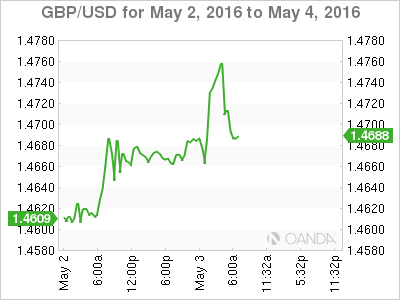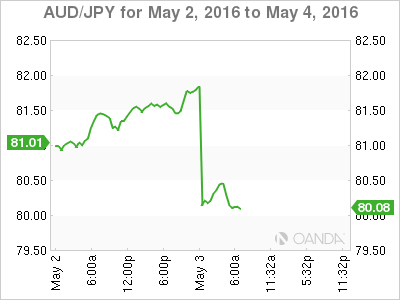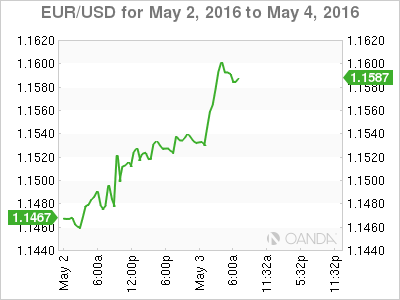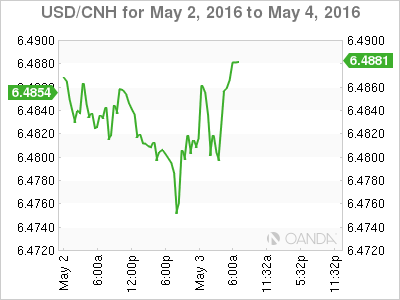It was an eerily quite North American trading session yesterday, influenced by a number of the major trading centers engaged in holiday activities.
In North America, market volumes were reported on the light side, and this despite U.S. factory activity slipping in April. The same cannot be said for early trading ahead of the U.S open – the dollar continues its relentless quest to underperform across the board, falling again against all of its major trading partners. The perceived delay in the timing of the next Fed rate hike remains the main catalyst for the greenbacks decline.
Yesterday, U.S ISM manufacturing index fell more than expected, easing to 50.8 in April from 51.8 in March. New orders dropped to 55.8 from 58.3, while prices paid index rose to 59.0 from 51.5.
Overall, the headline print is not great news, but it has remained in expansion territory for two-consecutive months after spending five-months in contraction. For the neutral, a tentative sign of growth and optimism in the U.S manufacturing sector, an area that’s been beaten up by low oil prices and a stronger dollar.
1. Pound erases all of 2016-dollar losses
In overnight trading, the magnitude of the ‘mighty’ dollar’s demise can be highlighted by the recent movements of the pound. In European mid-morning trading, sterling climbed to its highest level for this year outright, again putting the pound (£1.4760) briefly back into positive territory against the greenback for the year.
Sterling was up by as much as +0.70%, before weak PMI (49.2 vs. 51.3) data caused sterling to pare some of its earlier gains. The dollar is weaker across the board, by around -0.65% against the EUR (€1.1591) and -0.5% against the yen (¥105.75). Expect dealers debating of when and where the Bank of Japan (BoJ) could possibly intervene to curb the “one-sidedness” of the yen moves to only grow louder.
Sterling bulls still have Brexit to deal with!
2. Reserve Bank of Australia (RBA) sides with money markets
In its monetary policy decision overnight, the RBA decided that the best policy was to implement further easing, side stepping market analysts consensus expecting a rate hold.
Governor Stevens and company noted that the reduced risks in housing inflation allowed them to focus on making economic recovery more sustainable in deciding to cut rates by -25bps to new record low of +1.75%.
The RBA noted that Aussie labor indicators have become more “mixed,” and that economic growth has become more “moderate.” This afforded Aussie policy makers the latitude to make the surprise overnight rate move.
Latest multi-year lows in inflation CPI figures were also deemed decisive in the RBA’s decision. Aussie policy makers noted that the “price data were unexpectedly low, and coupled with cost pressures overseas, would risk a lower outlook for inflation than previously forecast.”
Naturally, the AUD has underperformed across the board, down -1.69% outright to A$0.7573.
3. EU sees weaker regional growth on back of China
This morning a group of economists at the European Commission has warned that the economic slowdown in China and other emerging markets, geopolitical tensions and uncertainty ahead of the U.K. referendum on EU membership could weigh on the bloc’s economy.
The EU’s economists also cautioned that the strength of factors that have been supporting growth in the region (low oil prices and weak EUR), could start to fade, while fundamental problems (high levels of private debt and unemployment) in many of the bloc’s economies could continue to hold back the economic recovery.
The commission have again revised the EU’s growth forecasts. They foresee the 19-country eurozone growing +1.6% this year, down from the +1.7% expansion seen in February. In 2017, the region is expected to expand by +1.8% vs. +1.9%.
4. Weak Chinese data pressures equities
Another downbeat reading on Chinese manufacturing is bringing concerns about the world’s second-largest economy back to the surface. This has again got “risk on” trading strategies under pressure.
Overnight, China’s April Caixin PMI manufacturing (unofficial) has retreated, recording its fourteenth consecutive month of contraction (49.4 vs. 49.8) thanks mostly to sluggish new orders and soft foreign demand for Chinese goods. The disappointing headline print matches the slight retreat in the “official” figures released over the weekend.
Local analysts indicate that their economy lacks a solid foundation for recovery, recommending that the Chinese government continue to closely monitor for risks of a further economic downturn.
5. ECB: Investors Are Profiting From Pre-Release U.S Data
Researchers from the European Central Bank (ECB) on both sides of the Atlantic said yesterday that they have “strong evidence” that investors are profiting on U.S. economic data before it is released.
In a study examining 21 U.S. economic data releases, a third of the cases saw the futures markets drifting in the correct direction a half hour before the official headline release. The report estimates that approximately $20m a year has been made on pre-release futures trading (U.S home sales, preliminary GDP and industrial production) since 2008.
The researches are calling for an investigation to determine the source of this “informed” trading.
This article is for general information purposes only. It is not investment advice or a solution to buy or sell securities.
Opinions are the authors — not necessarily OANDA’s, its officers or directors. OANDA’s Terms of Use and Privacy Policy apply. Leveraged trading is high risk and not suitable for all. You could lose all of your deposited funds.
Recommended Content
Editors’ Picks
USD/JPY holds above 155.50 ahead of BoJ policy announcement

USD/JPY is trading tightly above 155.50, off multi-year highs ahead of the BoJ policy announcement. The Yen draws support from higher Japanese bond yields even as the Tokyo CPI inflation cooled more than expected.
AUD/USD extends gains toward 0.6550 after Australian PPI data

AUD/USD is extending gains toward 0.6550 in Asian trading on Friday. The pair capitalizes on an annual increase in Australian PPI data. Meanwhile, a softer US Dollar and improving market mood also underpin the Aussie ahead of the US PCE inflation data.
Gold price keeps its range around $2,330, awaits US PCE data

Gold price is consolidating Thursday's rebound early Friday. Gold price jumped after US GDP figures for the first quarter of 2024 missed estimates, increasing speculation that the Fed could lower borrowing costs. Focus shifts to US PCE inflation on Friday.
Stripe looks to bring back crypto payments as stablecoin market cap hits all-time high

Stripe announced on Thursday that it would add support for USDC stablecoin, as the stablecoin market exploded in March, according to reports by Cryptocompare.
US economy: Slower growth with stronger inflation

The US Dollar strengthened, and stocks fell after statistical data from the US. The focus was on the preliminary estimate of GDP for the first quarter. Annualised quarterly growth came in at just 1.6%, down from the 2.5% and 3.4% previously forecast.



